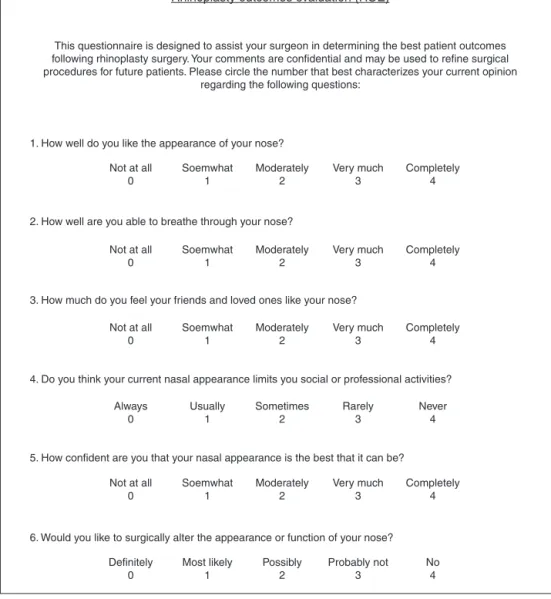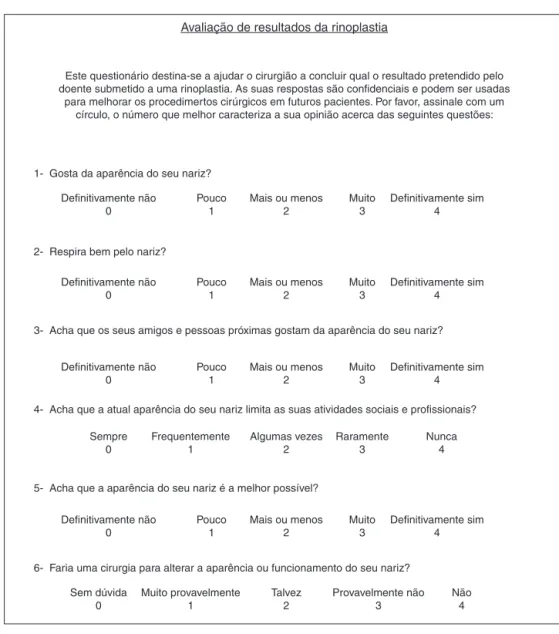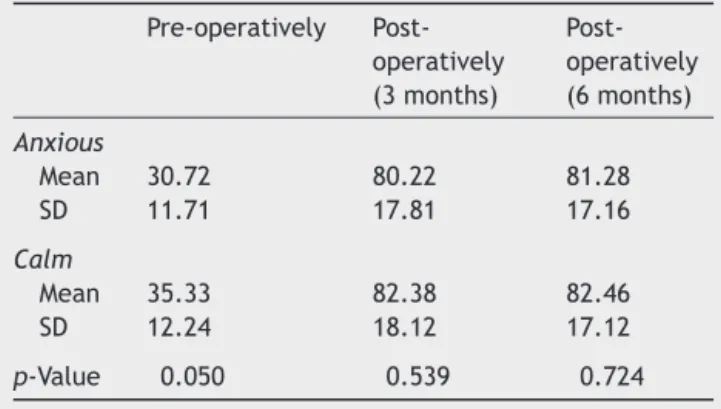www.bjorl.org
Brazilian
Journal
of
OTORHINOLARYNGOLOGY
ORIGINAL
ARTICLE
Evaluation
of
aesthetic
and
functional
outcomes
in
rhinoplasty
surgery:
a
prospective
study
夽
Sara
Sena
Esteves
∗,
Miguel
Gonc
¸alves
Ferreira,
João
Carvalho
Almeida,
José
Abrunhosa,
Cecília
Almeida
e
Sousa
CentroHospitalardoPorto,DepartamentodeOtorrinolaringologia,Porto,Portugal
Received2June2016;accepted30June2016 Availableonline20July2016
KEYWORDS
Rhinoplasty; Aesthetics;
Patientsatisfaction; Questionnaire; Outcomesevaluation
Abstract
Introduction:Evaluationofsurgeryoutcomemeasuredbypatientsatisfactionorqualityoflife isveryimportant, especially inplasticsurgery.Thereisincreasing interestinself-reporting outcomesevaluationinplasticsurgery.
Objective:Theaimofourstudywastodeterminepatientsatisfactioninregardtonose appear-ance andfunction with theuse of avalidated questionnaire, before and after rhinoplasty surgery.
Methods:A prospective study was realized at a tertiary centre. All rhinoplasty surgeries performedinadultsbetween February 2013andAugust2014were included.Many patients underwentadditionalnasalsurgerysuchasseptoplastyorturbinoplasty.Thesurgicalprocedures andpatients’characteristicswerealsorecorded.
Results:Among 113 patients, 107 completed the questionnaires and the follow-up period. Analysis ofpre-operativeandpost-operativeRhinoplasty Evaluation Outcomeshowed a sig-nificantimprovementafter3and6monthsinfunctionalandaestheticquestions(p<0.01).In thepre-operative, patientsanxious andinsecurehadaworse score(p<0.05). Differencein improvementofscoreswasnotsignificantwhengroupswere dividedonbasisofothernasal procedures,primaryorrevisionsurgeryandopenversusclosedapproach.
Conclusion:Wefound thatpatients withlowerliteracy degreeweremoresatisfiedwiththe procedure.Rhinoplastysurgery significantlyimproved patient quality oflife regardingnose functionandappearance.
© 2016 Associac¸˜ao Brasileira de Otorrinolaringologia e Cirurgia C´ervico-Facial. Published by Elsevier Editora Ltda. This is an open access article under the CC BY license (http:// creativecommons.org/licenses/by/4.0/).
夽 Pleasecitethisarticleas:SenaEstevesS,Gonc¸alvesFerreiraM,CarvalhoAlmeidaJ,AbrunhosaJ,AlmeidaeSousaC.Evaluationof aestheticandfunctionaloutcomesinrhinoplastysurgery:aprospectivestudy.BrazJOtorhinolaryngol.2017;83:552---7.
∗Correspondingauthor.
E-mail:sara.sena.esteves@gmail.com(S.SenaEsteves).
PeerReviewundertheresponsibilityofAssociac¸ãoBrasileiradeOtorrinolaringologiaeCirurgiaCérvico-Facial.
http://dx.doi.org/10.1016/j.bjorl.2016.06.010
PALAVRASCHAVE
Rinoplastia; Estética; Satisfac¸ãodo paciente; Questionário; Avaliac¸ãodos desfechos
Avaliac¸ãodosdesfechosestéticosefuncionaisemcirurgiaderinoplastia:umestudo
prospectivo
Resumo
Introduc¸ão: Aavaliac¸ãododesfechodecirurgiamedidopelasatisfac¸ãoouqualidadedevidado pacienteémuitoimportante,especialmenteemcirurgiaplástica.Existeuminteressecrescente naautoavaliac¸ãodedesfechosnestaespecialidadecirúrgica.
Objetivo: Oobjetivodesteestudofoideterminarasatisfac¸ãodopacienteemrelac¸ãoà aparên-ciaefunc¸ãodonarizcomousodeumquestionáriovalidado,antesedepoisdacirurgiade rinoplastia.
Método: Estudoprospectivorealizadoemumcentroterciário.Todasascirurgiasde rinoplas-tia realizadas emadultos entrefevereirode 2013e agostode2014foramincluídas.Muitos pacientesforamsubmetidosàcirurgianasaladicional,comoseptoplastiaouturbinoplastia.Os procedimentoscirúrgicoseascaracterísticasdospacientestambémforamregistrados. Resultados: Entre 113 pacientes, 107 completaram os questionários e o período de acom-panhamento. A análise da avaliac¸ão do desfechode rinoplastia (ADR) no pré-operatório e pós-operatório mostrou umamelhorasignificativaapós3e6meses emquestões funcionais eestéticas(p<0,01).Nopré-operatório,ospacientesansiososeinsegurosapresentaramum escorepior(p<0,05).Adiferenc¸anamelhoriadosescoresnãofoisignificativaquandoos gru-posforamdivididoscombaseemoutrosprocedimentosnasais,cirurgiaprimáriaourevisãoe abordagemabertaversusfechada.
Conclusão:Verificou-se quepacientescommenorgraudealfabetizac¸ãoestavammais satis-feitoscomoprocedimento.Acirurgiaderinoplastiamelhorousignificativamenteaqualidade devidadopacientequantoàfunc¸ãoeaspectodonariz.
© 2016 Associac¸˜ao Brasileira de Otorrinolaringologia e Cirurgia C´ervico-Facial. Publicado por Elsevier Editora Ltda. Este ´e um artigo Open Access sob uma licenc¸a CC BY (http:// creativecommons.org/licenses/by/4.0/).
Introduction
Evaluationofsurgeryoutcomemeasuredbypatient satisfac-tionorqualityoflifeisveryimportant,especiallyinplastic surgery. There aremany areas in otolaryngologyin which outcomesarebeingevaluatedsuchasheadandneck oncol-ogy, acutesinusitis and obstructivesleepapnea. There is increasinginterestinself-reportingoutcomesevaluationin plasticsurgery, beingthefacialplasticsurgeryoneof the mostimportantareasofresearch.Outcomesofanysurgical procedurecanbemeasuredbyquantitativeand/or qualita-tiveterms.Inthecaseofplasticsurgery,theproceduresare generallyelective andundertaken for cosmetic purposes, andassuchanalysisofquantitativeparameterslikedaysof internment,morbidityandmortalitymaybeapplicablebut arenotrelevant.Therefore,facialplasticsurgeonsmeasure successbasedonqualitativeevaluations.However,thelack ofastandardized qualitativeassessmentmakesitdifficult tocompareobjectivelythesuccessofdifferenttechniques andindividualsurgeons.
Self-reportingonoutcomesisincreasinglyrecognizedas an important outcome in clinical trials or to assess the effectivenessof medicalprocedures.Therefore, question-naires designed toevaluate qualityof life and self-image are very helpful in assessing the success of facial plastic surgeryastheystandardizethe collectedinformationand allowobjectivecomparisonofproceduresbymeasuring pos-itive and negative effects aswell as improvements after
rhinoplasty.1---3 Patient satisfaction depends on subjective
factorssuchaspatientperceptionofpre-operative appear-ance,patient expectations, socialrelationship capacities, alcohol intake and temperament.4 Compared with
pri-maryrhinoplasty,revisionrhinoplastyisamorechallenging surgerybecauseits main goalis tocorrectthe functional and/or cosmeticdefects or complaintsafter the previous surgery failed to meet patient expectations.5 Therefore,
understandingpatientexpectationspre-operatively is cru-cialtoachievethedesiredoutcomes.6Surgeonandpatient
aregenerallynotsimilarlypleasedwiththeprocedure,since theexpectationsandopinionsaredifferent.
In2000,Alsarrafetal.werethefirsttocreateandtesta questionnairewithreliability,internalconsistencyand valid-ityforseveralplasticsurgeries,includingrhinoplasty.7,8This
questionnaire,theRhinoplastyOutcomesEvaluation(ROE), allowedmeasureofqualitativeaspectssuchassocial, emo-tionalandpsychologicalvariables (Fig.1).InPortugalthe study of patient satisfactionafter rhinoplasty has been a neglectedareamainlydue toabsenceofvalidated instru-mentstoassess theobjectiveandsubjective outcomesof theprocedure. In2013, SenaEstevesetal. validatedthis ROEquestionnairetoPortuguese.9
Rhinoplasty outcomes evaluation (ROE)
This questionnaire is designed to assist your surgeon in determining the best patient outcomes following rhinoplasty surgery. Your comments are confidential and may be used to refine surgical procedures for future patients. Please circle the number that best characterizes your current opinion
regarding the following questions:
1. How well do you like the appearance of your nose?
2. How well are you able to breathe through your nose?
3. How much do you feel your friends and loved ones like your nose?
4. Do you think your current nasal appearance limits you social or professional activities?
5. How confident are you that your nasal appearance is the best that it can be?
6. Would you like to surgically alter the appearance or function of your nose?
Definitely 0
Most likely 1
Possibly 2
Probably not 3
No 4 Not at all
0
Soemwhat 1
Moderately 2
Very much 3
Completely 4 Not at all
0
Soemwhat 1
Moderately 2
Very much 3
Completely 4 Not at all
0
Soemwhat 1
Moderately 2
Very much 3
Completely 4 Not at all
0
Soemwhat 1
Moderately 2
Very much 3
Completely 4
Always 0
Usually 1
Sometimes 2
Rarely 3
Never 4
Figure1 EnglishversionofRhinoplastyOutcomesEvaluationquestionnaire.
Methods
TheResearchEthicsCommitteeofourhospitalapprovedthe studypriorstoinitiation(studyID:051/13).Weperformed aprospectivestudyofalladultsthatunderwentrhinoplasty betweenFebruary2013andAugust2014inatertiary cen-tre.Weidentified110patientsbut3patientswereomitted fromthestudyastheywereunresponsivetorepeatedphone calls.
Weincluded107patientswhounderwentapre-operative consultationwithanotolaryngologistandansweredtheROE questionnaire.Inaddition,thequestionnairesaskedpatient demographicdatasuchasage,sex,ethnicity,literacylevel, psychologicalaspects, reasonfor visitand researchabout aesthetic surgery before the consultation. Post-operative satisfactionwasevaluatedbyaphonecallat3and6months aftersurgery,bythesameotolaryngologist.Theperson mak-ingthephonecallwasnotnecessarilythesurgeon.Patients werealsoaskediftheywouldstillchoosetoundergo rhino-plasty,knowingthefinalresult.
The validated Portuguese version ofthe ROE question-nairewasusedanditiscomposedofsixquestions(5about
nose shape and 1 about nasal breathing). Each question is scored by the patient ona scale from 0 to4, where 0 is the most negative answer and 4 the most positive one (Fig.2).Thesumofthescoreswasdividedby24and mul-tiplied by 100 toobtain a resultranged from0 to100. A lower scoreindicates more dissatisfaction. A positive dif-ference between post-operative and pre-operative scores meansimprovementafterintervention.
Surgeonsalsoansweraquestionnaire,inthedayofthe surgery,aboutoperativetechniquesusedduringthe rhino-plasty,othernasalproceduresandpreviousrhinoplasty.
All patients seeking rhinoplasty, even in addition to othernasalproceduressuchasseptoplastyorturbinoplasty wereincludedinthestudy.Patientsyoungerthan18years and with congenital or neoplasticnasal deformities were excluded.
Thefollow-uptimewasatleast12months.
Avaliação de resultados da rinoplastia
Este questionário destina-se a ajudar o cirurgião a concluir qual o resultado pretendido pelo doente submetido a uma rinoplastia. As suas respostas são confidenciais e podem ser usadas
para melhorar os procedimertos cirúrgicos em futuros pacientes. Por favor, assinale com um círculo, o número que melhor caracteriza a sua opinião acerca das seguintes questões:
1- Gosta da aparência do seu nariz?
2- Respira bem pelo nariz?
3- Acha que os seus amigos e pessoas próximas gostam da aparência do seu nariz?
4- Acha que a atual aparência do seu nariz limita as suas atividades sociais e profissionais?
5- Acha que a aparência do seu nariz é a melhor possível?
6- Faria uma cirurgia para alterar a aparência ou funcionamento do seu nariz?
Sem dúvida 0
Muito provavelmente 1
Talvez 2
Provavelmente não 3
Não 4 Definitivamente não
0
Pouco 1
Mais ou menos 2
Muito 3
Definitivamente sim 4
Definitivamente não 0
Pouco 1
Mais ou menos 2
Muito 3
Definitivamente sim 4
Definitivamente não 0
Pouco 1
Mais ou menos 2
Muito 3
Definitivamente sim 4
Definitivamente não 0
Pouco 1
Mais ou menos 2
Muito 3
Definitivamente sim 4 Sempre
0
Frequentemente 1
Algumas vezes 2
Raramente 3
Nunca 4
Figure2 PortugueseversionofRhinoplastyOutcomesEvaluationquestionnaire.
Results
Afterinclusionandexclusioncriteriaweremet,107patients participatedisthisstudy.The samplewascomposedof 56 femaleand 51malepatients. The population wasdivided intothreegroups:18---29yearsold,30---49yearsoldand≥50 yearsold.Demographicscharacteristicsofthepatientsare detailedinTable1.
Thereasonsforundergoingrhinoplastywereaestheticin 4.7%ofpatients,functionalin13.1%andacombinationof aestheticandfunctionalin82.2%.Themajorityofpatients researched information about plastic surgery and rhino-plasty before the first otolaryngology consultation (57%). Whenweaskedinthepre-operativeconsultationiftheyhad anidealnosethattheywouldliketotransposetothem,96% answerednoand11%answeredyes.
It wasalso askedif the surgeonexplainedwhat would becorrected inthe nose surgery and2% answered notat all,10%answeredsomewhat,25%answeredmoderately,31% answeredverymuchand39%answeredcompletely.
Regardingpsychologicalaspects,59%ofthepatients con-sideredthemselvesanxiousand78%secure(Table2).
The mean ROE pre-operatively score was 32.8±12.1(range 8.3---58.3) and the mean score post-operatively was 81.2±17.9 at 3 months (range 25---100) and81.9±17.1 at 6 months (range 37.5---100). Statistical analysis of ROE scores showed significant improvement from pre-operative to post-operative period (p<0.05). However,therewasnodifferencebetween3and6months’ post-operativescores.
Thecorrelationbetweenpsychologicalaspectsand satis-factionispresentedinTable3,showingthatanxiouspatients weresignificantly less satisfied than calm patients in the pre-operativeperiod.
Therewerenogenderdifferencesinmeanpost-operative scores (p>0.05), but the mean post-operative score of patientswithhigherliteracydegreewerelower,indicating lesssatisfaction(p<0.05).
Primary rhinoplasty was performed in 87.9% and revi-sionrhinoplastyin12.1%patients.Therewasnosignificant differencein post-operative ROE scores between the two groups.
Table1 Patientcharacteristics.
No.ofpatients %
Gender
Male 51 47.7%
Female 56 52.3%
Age(years)
18---29 47 43.9%
30---49 54 50.5%
≥50 6 5.6%
Ethnicity
Caucasian 107 100.0%
Literacydegree
Below9thgrade 9 8.4%
9thgrade 25 23.4%
12thgrade 42 39.3%
Collegedegree 21 19.6%
MSc/PhD 10 9.3%
Reasonforsurgery
Functional 14 13.1%
Aesthetic 5 4.7%
Both 88 82.2%
Table2 Psychologicalcharacteristics.
Insecure Secure Total
Anxious 23(21.5%) 36(33.6%) 59(55.1%) Calm 6(5.6%) 42(39.3%) 48(44.9%) Total 29(27.1%) 78(72.9%) 107(100.0%)
used were open rhinoplasty (n=27), delivery approach (n=35)andnon-deliveryapproach(n=45).Wefoundno sig-nificantdifferenceinROEscoreimprovementbetweenopen andclosedtechnique(p=0.765)orbetweenthetwoclosed techniques(p=0.071).
Therewere91 patientswhounderwentseptoplasty,88 turbinoplasty and 11 functional endoscopic sinus surgery. ROEscoreaftersurgerywasnotsignificantbetweenthese groups(p>0.05).
Table3 Meanpre-andpost-operativescoresand correla-tionwithpsychologicalaspects.
Pre-operatively Post-operatively (3months)
Post-operatively (6months)
Anxious
Mean 30.72 80.22 81.28
SD 11.71 17.81 17.16
Calm
Mean 35.33 82.38 82.46
SD 12.24 18.12 17.12
p-Value 0.050 0.539 0.724
SD,standarddeviation.
When asked if they would undergo the surgery again knowingthefinalresulttheywouldundergosurgery:72.9% answereddefinitely,11.2%probably,6.5%maybe,5.6% prob-ablynotand3.7%notatall.
Finally,itisimportanttonotethat100%ofpatientshad ahigherROEscoreaftersurgery,showingthatallpatients weremoresatisfiedaftertherhinoplasty.
Discussion
Rhinoplastyisamongthemostcommonsurgeriesperformed byfacialplasticsurgeonsworldwide.10
This procedure has low patient satisfaction compared withothercosmeticsurgeries.11 Patientsatisfactionisthe
principal outcome measure of success in facial cosmetic surgeries,yet mostsurgeonsdonotuse quantitativetools to access it. Patient’s satisfaction may be influenced by socialenvironment,education,lifeexperienceandlevelof expectations,whichmayormaynotberealistic.Complete photographicdocumentationisfundamentaltoboth physi-cian and patients for surgery planning and assessment of post-operativeresults.12 Inthe present studywe choseto
use theROE questionnairebecauseit wasvalidatedby us in Portugal.9This questionnaire quantifies theresultfrom
thesurgicalprocedure,assessingrespiratoryfunction, qual-ityoflifeandcosmeticresults.Surgeongoalistoimprove bothcosmeticandbreathing,andnotpurelytheaesthetic component.
Inthisprospectivestudywith107patientsweevaluate ROEscorebeforesurgeryandat3and6monthslater, allow-ingmorepreciseresultsaboutsatisfaction.
Ourresultsshowedstatisticallysignificantimprovement inROEscoresafterrhinoplasty,demonstratingahighindex ofsatisfactioninthispatientpopulation.Interestingly,the changeinROEscoreswashigherinlowerliteracypatients, which may be explained by lower pre-surgical expecta-tionsandlackofinformationandinternetaccess.Sex,age, primary versus revision surgery and additional nasal pro-ceduressuchasseptoplasty,turbinoplastyor FESSshowed nosignificant differencesin ROEscores. Ofnote, the sur-gical technique (open or closed) has no effect on the ROE scores after rhinoplastyshowing the outcome of the surgery was the same regardless the surgical approach used.
In our study the mean pre-operative ROE score was 32.78andthemeanimprovementwas49.03aftersurgery. These numbers are in line with those reported by Alsar-rafetal.,whichfoundameanpre-operativescoreof38.8 andameanimprovementof44.5.8Althoughthesignificant
improvement in ROE scores in our population, only 72.9% would definitely choose to undergo the same procedure again.
Inoursampletherewere51menand56women,which showsthatmenareincreasinglyconcernedabouttheir phys-icalappearance.
Prospectivestudiesarereallyimportantsincethey per-mit to choose good candidates for surgery and to assess objectivelysurgeryresults.
This study wasconducted in an otolaryngology depart-ment of a central public hospital composed of senior specialistsandresidents.Onelimitationofthestudyisthe fact ofrhinoplasty beingperformed by differentsurgeons withdifferent levelsof experience in the aestheticarea. Therefore,bothexpectationscreatedinthepre-operative consultationandthepost-operativesatisfactionsurveymay beaffectedbytheseconditions.
Conclusions
We conclude the ROE questionnaire is a useful tool for evaluating outcomes of rhinoplasty surgery. Ourpatient’s satisfactionat 3and6monthsimprovedsignificantlyafter rhinoplasty.Thekindofsurgicalapproachandnasal proce-dureshadnoinfluenceonpost-operativesatisfactionscores. However,patientswithlowerliteracywere moresatisfied withtheprocedure.
Rhinoplastysurgerysignificantlyimprovedpatientquality ofliferegardingnosefunctionandappearance.
Conflicts
of
interest
Theauthorsdeclarenoconflictsofinterest.
References
1.ChingS,ThomaA,McCabeRE,AntonyMM.Measuringoutcomes inaestheticsurgery:comprehensivereviewoftheliterature. PlastReconstrSurg.2003;111:469---80.
2.McKinneyP,CookJQ.Acriticalevaluationof200rhinoplasties. AnnPlastSurg.1981;7:357---61.
3.GuyuronB,BokharF.Patientsatisfactionfollowingrhinoplasty. AesthetPlastSurg.1996;20:153---7.
4.MeyerL,JacobssonS.Thepredictivevalidityofpsychosocial factorsforpatientacceptanceofrhinoplasty.AnnPlastSurg. 1986;17:513---20.
5.HellingsPW, NolstTrenitéGJ.Long-termpatientsatisfaction afterrevisionrhinoplasty.Laryngoscope.2007;117:985---9. 6.RohrichRJ.Mirror,mirroronthewall:whenthepostoperative
reflectiondoesnotmeetpatients’expectations.PlastReconstr Surg.2001;108:507---9.
7.AlsarrafR.Outcomesresearchinfacialplasticsurgery:areview andnewdirections.AesthetPlastSurg.2000;24:192---7. 8.AlsarrafR,LarrabeeWFJr,AndersonS,MurakamiCS,Johnson
CMJr.Measuring cosmeticfacialplastic surgeryoutcomes:a pilotstudy.ArchFacialPlastSurg.2001;3:198---201.
9.Esteves SS, Silva AP, Ferreira MG, Ferreira A, Ferreira P, Abrunhosa J, et al. Validation ofRhinoplasty Outcome Eval-uation (ROE) Questionnaire to Portuguese. Rev Port ORL. 2015;53:81---5.
10.ApaydinF.Rhinoplastyattheglobalcrossroads.ArchFacialPlast Surg.2009;11:421---3.
11.FreibergA,GiguereD,RossDS,TaylorJR,BellT,KerlukeLD. Are patientssatisfied withresultsfrom residentsperforming aestheticsurgery.PlastReconstrSurg.1997;100:1824---31. 12.Sullivan MJ. Rhinoplasty: planning photodocumentation and


